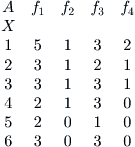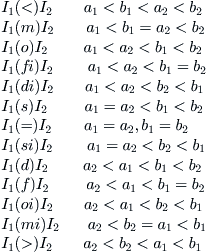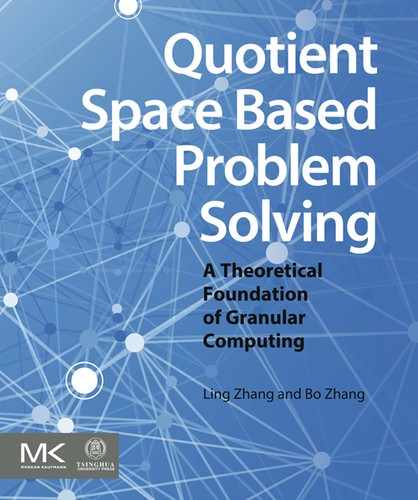1.3. The Acquisition of Different Grain-Size Worlds
What are the principles of partitioning or granulation of the worlds? Certainly, some of them are domain-dependent. Some are not. We now discuss the general principles.
Granulation problem can be performed in three different ways.
First, the granulation is directly executed on domains (or universes). A domain is partitioned into regions with different sizes, and then we have a new grain-size world.
Second, the granulation is first performed on attribute values f. And then the domain is accordingly partitioned based on the granulation of f.
Third, the granulation is carried out on structure T. The domain is then partitioned based on the granulation of T.
1.3.1. The Granulation of Domain
1. Function Based Granulation
2. Constraint-Based Granulation
Given n constraints  , and a domain X, we may partition X according to
, and a domain X, we may partition X according to  . That is, for constraint
. That is, for constraint  , X is divided into two classes. One satisfies
, X is divided into two classes. One satisfies  . The other does not. Then, the two classes are further divided into two sub-classes, respectively, according to
. The other does not. Then, the two classes are further divided into two sub-classes, respectively, according to  and so on. So we have a 2-ary tree structure of X.
and so on. So we have a 2-ary tree structure of X.
Obviously, for each  , X can be divided into more than two classes, which satisfy
, X can be divided into more than two classes, which satisfy  in various degrees. We then end up with a general tree structure of X.
in various degrees. We then end up with a general tree structure of X.
In reality, this kind of granulations is used extensively.
Example 1.1
Suppose that we design a building which must satisfy a lot of constraints, such as two floors, three bedrooms, the area of dining room must be greater than 10 square meters, etc. First, we have a building sketch which only satisfies some main constraints. Then, the sketch is refined. Finally, we have a complete design. From the hierarchical point of view, the building sketch can be regarded as an equivalence class consisting of all sorts of buildings that satisfy the main constraints. Then the equivalence class is gradually partitioned into the final design via the refining of the sketch.
3. Granulation by Combination
From a known quotient space  , its supremum
, its supremum  and infimum
and infimum  quotient spaces may be obtained. Then, we have three quotient sets with different granularities. Through intersection and union operations over the three quotient sets, we have a new quotient set and its corresponding quotient space (see Section 1.4 for more details).
quotient spaces may be obtained. Then, we have three quotient sets with different granularities. Through intersection and union operations over the three quotient sets, we have a new quotient set and its corresponding quotient space (see Section 1.4 for more details).
1.3.2. The Granulation by Attributes
Partition attribute values first, then the corresponding partition of the domain is obtained.
1. Granulation by Attribute Values
Assume that  is an attribute function. If f is single-valued, then X can be partitioned in accordance with attribute values Y. Usually, we are familiar with Y, for example, Y is a real number or a Euclidean space
is an attribute function. If f is single-valued, then X can be partitioned in accordance with attribute values Y. Usually, we are familiar with Y, for example, Y is a real number or a Euclidean space  . We can classify X by using Y as follows.
. We can classify X by using Y as follows.
Assume that  is a partition of Y. Define:
is a partition of Y. Define:
![]()
Example 1.2
X is a set of examinees attending the nation-wide university's entrance examination. For each examinee  indicates his total test scores (TTS). Let
indicates his total test scores (TTS). Let  . Divide Y into
. Divide Y into  ,
,  ,
,  , and
, and  , where 520 is the minimal TTS required for admission to key universities, 460 is the minimal TTS for general universities, 420 is the minimal TTS for institutes.
, where 520 is the minimal TTS required for admission to key universities, 460 is the minimal TTS for general universities, 420 is the minimal TTS for institutes.
Define:  .
.
X4 is the set of examinees admitted to key universities, X3 is the set of examinees admitted to general universities, etc. In a word, based on the partition of a subset [0,700] of real numbers, we have a corresponding partition of examinees.
Granulation by attribute values is extensively used in rough set theory (Pawlak, 1982). Assume that  , denoted by
, denoted by  in rough set, is a data table (information system), where
in rough set, is a data table (information system), where  . Ai is the quotient set corresponding to
. Ai is the quotient set corresponding to  . Granulation by attribute values is sometimes called the quantification of attribute values.
. Granulation by attribute values is sometimes called the quantification of attribute values.
Define  . Xi is a quotient set of X, where
. Xi is a quotient set of X, where  is the granulation of f. If X is simultaneously granulated by
is the granulation of f. If X is simultaneously granulated by  and
and  , the corresponding quotient space obtained is denoted by
, the corresponding quotient space obtained is denoted by  .
.  is the supremum of
is the supremum of  and
and  . Using all combinations of the quantification of attribute values, the corresponding quotient spaces (sets) gained are all possible quotient spaces that can be obtained by the granulation based on the attribute values. One of the main goals in rough set analysis is to choose a proper one from among all the possible quotient spaces so that the recognition or classification task can be effectively achieved.
. Using all combinations of the quantification of attribute values, the corresponding quotient spaces (sets) gained are all possible quotient spaces that can be obtained by the granulation based on the attribute values. One of the main goals in rough set analysis is to choose a proper one from among all the possible quotient spaces so that the recognition or classification task can be effectively achieved.
Example 1.3
Assume that X is a set of freshmen. The constitution of the freshmen can be described by several attributes such as  height,
height,  weight,
weight,  sight, etc. Sometimes, we are only concerned with some of them and classify the freshmen based on these attributes. This classification is regarded as a projection-based method.
sight, etc. Sometimes, we are only concerned with some of them and classify the freshmen based on these attributes. This classification is regarded as a projection-based method.
Example 1.4
A data table  is given below.
is given below.

Based on attribute values we have the following quotient spaces. denotes the supremum operation.
denotes the supremum operation.

![]()
If all quotient spaces in a semi-order lattice, which order is decided by the inclusion relation of subsets of attributes, are given, the so-called ‘attribute reduction’ in rough set theory is to find the simplest supremum within the semi-order lattice, where the ‘simplest’ means the minimal number of attributes.
In rough set theory, given a quotient space (knowledge base) and a set S, if S can be entirely represented by the union of elements in the quotient space, S is called crisp or discernible, otherwise, indiscernible. The indiscernible set can be represented by the upper and lower approximation sets.
‘Fuzziness’ is an inevitable outcome of his/her observation when he/she watches the world at a coarse grain-size. So the concept of fuzziness is closely related to granularity and can be described by quotient spaces with different granularities. Using the elements of a set of quotient spaces to depict ‘fuzziness’, the cost is greatly reduced since the potential of quotient spaces is much less than that of the original space. The description of fuzziness by membership functions in fuzzy set theory (Zadeh, 1965) is very expensive. The description of fuzziness in rough set theory is less expensive but still much more expensive than the quotient space description.
When ‘fuzziness’ appears in our observation, this means that we are lacking detail. If we use an elaborate tool to describe a ‘fuzzy’ object in detail, it seems unreasonable. Thus, the representation of fuzziness by membership functions in fuzzy set theory is not necessarily an effective method.
2. Projection-Based Partition
Assume that f is multi-dimensional. Let its n attribute components be  , X is classified with respect to
, X is classified with respect to  values, while ignoring their attribute components
values, while ignoring their attribute components  . This method is said to be a projection-based method.
. This method is said to be a projection-based method.
The geometrical interpretation of the projection-based method is that observing the same object from different view-points. For example, the three perspective drawings of a mechanical part are based on the projection-based method.
1.3.3. Granulation by Structures
1. Coarse Topology
Problem  is given. Assume that T1 is a topology on X denoted by
is given. Assume that T1 is a topology on X denoted by  .
.
Definition 1.6
Given  , T1 and T1 < T. Define an equivalence relation R on X as
, T1 and T1 < T. Define an equivalence relation R on X as  , where
, where  is an open neighborhood of x(y) on T1.
is an open neighborhood of x(y) on T1.
Example 1.5
A topologic space  , where
, where
![]()
Let  , T1<T.
, T1<T.
Then, we have X1 and quotient space  , where X1 = X.
, where X1 = X.
Since the quotient topology [T] of X1 is T,  cannot be obtained from domain granulation.
cannot be obtained from domain granulation.
An example is given below to show how to use the structure-based granulation to problem solving.
Example 1.6
In a temporal world model presented by Allen (1981, 1983, 1984), there are 13 temporal relations between two events, i.e.,  . For two events
. For two events  and
and  , their 13 temporal relations are defined as follows.
, their 13 temporal relations are defined as follows.

Assume that X is a set of events in question. All time intervals that events happened in are regarded as attribute functions, the 13 temporal relations as structure T. Then, temporal planning is transformed into solving problem  .
.
Coarsening structure T, e.g., 13 temporal relations are simplified to eight relations T1 as follows.
![]()
Quotient structure T1 is obtained from structure T by merging both  and
and  into
into  , and both
, and both  and
and  into
into  .
.
Define quotient set  , where
, where  is a set of temporal relations between events x and y.
is a set of temporal relations between events x and y.
Quotient space  is coarser than the original space
is coarser than the original space  . In Chapter 6, we will show the problem solving based on the coarsening structure and by using the corresponding falsity preserving, etc. properties to reduce the computational complexity in problem solving.
. In Chapter 6, we will show the problem solving based on the coarsening structure and by using the corresponding falsity preserving, etc. properties to reduce the computational complexity in problem solving.
2. Classification with Overlapped Elements
In some cases, some  may belong to more than one class. For example, in an electronic instrument, one part may be contained in two different components. That is, the classification has overlapped elements or the contours of classes are blurred. We have:
may belong to more than one class. For example, in an electronic instrument, one part may be contained in two different components. That is, the classification has overlapped elements or the contours of classes are blurred. We have:
Definition 1.7
Assume that X is a domain,  is a subset of X, where I is a set of subscripts. If
is a subset of X, where I is a set of subscripts. If  , regarding Ai as a set of new elements, then
, regarding Ai as a set of new elements, then  is a new abstraction level.
is a new abstraction level.
It should be noted that  , doesn't always hold here. In order to distinguish the classification with overlapped elements, we use angle brackets < > instead of square brackets [ ]. Here the symbol Ai is used for representing both subsets of X denoted by
, doesn't always hold here. In order to distinguish the classification with overlapped elements, we use angle brackets < > instead of square brackets [ ]. Here the symbol Ai is used for representing both subsets of X denoted by  , and elements of
, and elements of  denoted by
denoted by  .
.
In Chapter 2, we will discuss one specific case, i.e., tolerant relations, of classification with overlapped elements.
..................Content has been hidden....................
You can't read the all page of ebook, please click here login for view all page.
